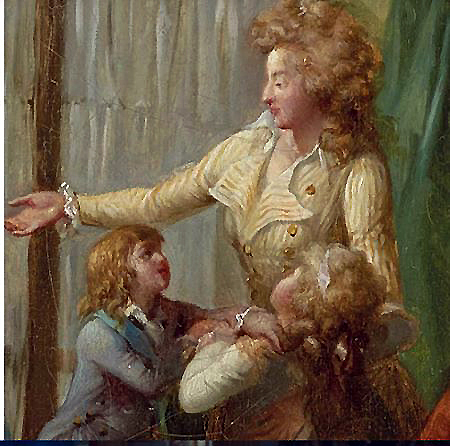HER COURAGE WHEN FACED WITH A CROWD WANTING TO KILL HER CONTRADICTS HER FRIVOLOUIS IMAGE
-- Pages based on Histoire de la Révolution française, the classic by Jules Michelet (1853).
On October 5, 1789 7-8,000 women seize arms at City Hall and march on Versailles, to demand grain and bring the king back to Paris.
Fuite de Passy à Versailles ("The flight from Passy to Versailles"), a famous print (Passy is a wealthy suburb on the route to Versailles) / zoom
Militants threaten to cut the hair of women who do not join them.
"The certain cause, for the women, for the crowd of the most miserable, was hunger. Having made a rider dismount, they killed the horse and ate it almost raw.
Would the men have marched on Versailles if the women had not preceded them? Probably not. No one had had the idea of going to find the king."
Michelet on the women's engagement:
"Great misery is fierce, it strikes the most feeble."
Women were more exposed to hunger than men because more isolated, with children who cried and died, or seamstresses who worked alone (he does not mention washerwomen, whose work was sociable). Not all militants, he adds, were hungry, such as market-women and prostitutes, but misery surrounded them.
Bring the king back to Paris:
"The King must live with his people, feel and share the suffering [...] If Kingship be not tyranny, there must be a mariage, a community [...] Is it not strange and unnatural, enough to dry the heart of kings, to keep them in selfish solitude, with an artificial crowd of golden beggars, to make them forget the people? How be surprised that such kings become hard and barbarous strangers?"
# # #
The march was much tougher than the famous picture and this movie shows. It was a cold, rainy October day and the crowd walked in mud.
- One woman seized a drum from guards and beat as they advanced through the streets. Others joined them:
The child is imaginary but the drumbeat's stirring call was real.
- Thousands of women arrived at Versailles toward 16h. The National Guard led by Lafayette* and a crowd of men joined them a few hours later.
*Americans' only foreign hero was active in both revolutions.
 |
| Internet, no source named |
- The king received a delegation of women. He agreed to send grain to Paris and to sign the Declaration of the Rights of Man and the Citizen, and said he would think about coming to Paris.
- The throng camped out in the palace's huge courtyard:
ayette, who was responsible for the king's safety, thought all was well, went to sleep and woke up only after the mob had stormed the palace: He would be called "General Morpheus."
# # #
At dawn on October 6, people broke through the gates and sought to kill the queen:
- Chambermaids locked the door and helped Marie-Antoinette throw on a dress:
Here and below, Marie-Antoinette by Jean Delannoy with Michèle Morgan, 1956
They took a secret passage that led to the king's room, but he had left to look for them. They rushed through the palace to find him. A locked door added to the panic: It was five minutes before a servant heard the terrified pounding.
- Two guards who tried to protect the queen were killed:
"Massacre of a Guard at the Queen's Apartment, by brigands" print by J-F Janinent / zoom
- The queen and the chambermaids finally found the king, the children, their governess and Lafayette, in the salon that looks out on the courtyard:
Le General La Fayette met en garde le Roi et la Reine ("General La Fayette warns the King and Queen") by Jean-Frédéric Shall, before 1825, zoom
- Louis refused to let his troops fire on the crowd and tried to talk to it...
But it demanded the queen. When she came out on the balcony with the children the mob screamed, "No children!"
After the terrifying awakening and the frantic rush through the palace, Marie-Antoinette calmly faced the throng that had wished to kill her:
The king was forced to settle in Paris, asking only that his family come too. "The royal coach, La Fayette riding alongside it, advanced like a hearse."
-- Michelet. The account below comes from the memoir of Madame Campon, whose sister was present.
- His carriage led the march, to drumbeats and the shooting of muskets. The mob was so close to the coach that it swayed from side to side, carrying the heads of the slaughtered guards on pikes ahead of it. The court followed in a hundred coaches:
 |
La Fuite de Louis XVI by Viktor Lazarevski, 2013 / Youtube
|
"In the midst of that troop of cannibals rose up the two heads of the massacred guards. The monsters, who had made trophies of them, had the atrocious idea of forcing a wig-maker to re-style their coiffures by powdering their bloodied heads...
- Parisians celebrated the arrival of bags of grain and the royal family by dancing in the streets:
Louis XVI entre à Paris, le 6 octobre 1789 ("Louis XVI enters Paris, October 6 1789") by J.F.J. Swebach, 1789 / zoom # # #
If you visit the château of Versailles you will cross through the courtyard and pass under the balcony:
Think of the mob, the massacred guards and the courage of Marie-Antoinette.
# # #
The musée Carnavalet (the historical museum)
and skips this drama.
* * *


.jpg)






.jpg)
.jpg)
.jpg)









.jpg)






















